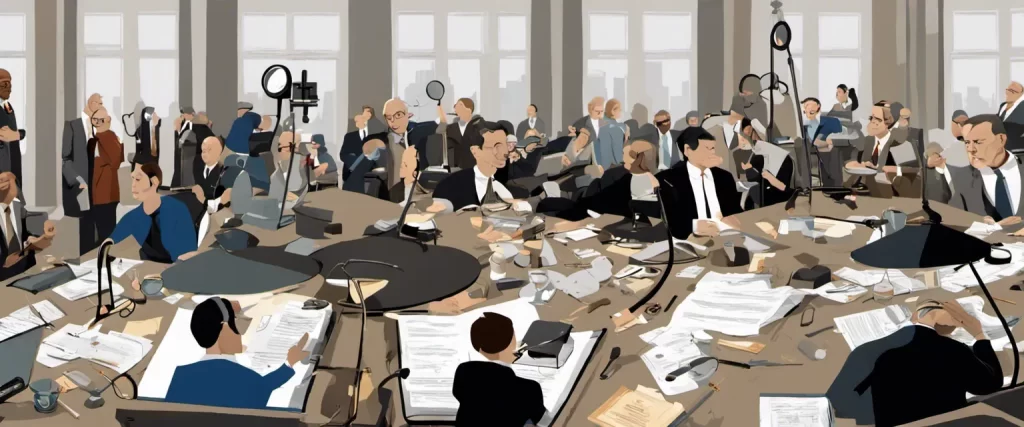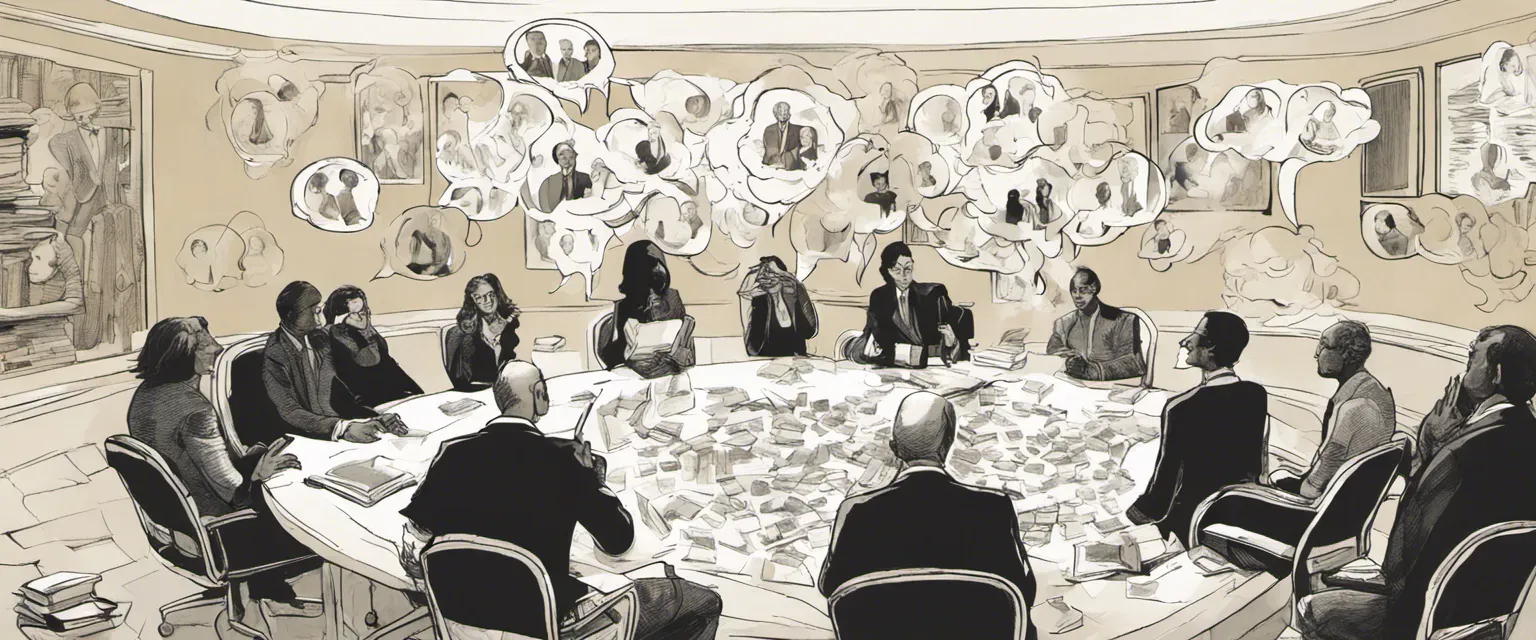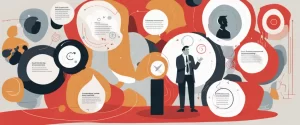——The Smartest Guys in the Room by Bethany McLean & The Courage to Act by Ben S. Bernanke
In the realm of non-fiction literature, the power of knowledge becomes evident through the exploration of captivating narratives that dive into pressing societal issues. In their respective works, “The Smartest Guys in the Room” by Bethany McLean and “The Courage to Act” by Ben S. Bernanke, both authors delve into critical events that shaped the modern world and scrutinize the decisions made by key figures. While one examines the collapse of a financial giant, the other dissects the aftermath of the worst economic downturn since the Great Depression. However, beneath their seemingly disparate subjects lies a common thread that binds these two books together – a scrutiny of leadership and its impact on both individuals and society at large.
The Smartest Guys in the Room” unravels the gripping saga of Enron, once hailed as an exemplar of corporate ingenuity before its shocking and utter collapse. Bethany McLean, an investigative journalist, presents a scathing account of how the arrogance and greed of a few individuals led to the company’s demise. With meticulous research and insightful analysis, McLean exposes the underlying corruption, inflated profits, and fraudulent practices that characterized Enron’s rise and subsequent downfall. Through the lens of Enron’s leadership, the book raises pertinent questions about moral responsibility in business and the swathes of destruction that can be wreaked by unchecked power.
Meanwhile, “The Courage to Act” takes readers on a riveting journey through the tumultuous years following the 2008 global financial crisis, as seen through the eyes of Ben S. Bernanke, the Chairman of the Federal Reserve during that period. Bernanke presents an insider’s perspective on the unprecedented actions taken by central banks, regulatory agencies, and governments worldwide to stabilize the faltering global economy. He discusses the consequences of these actions, both intended and unintended, shedding light on the complexities of crisis management and the burden of leadership during times of immense pressure. Additionally, Bernanke reflects upon the lessons learned from this crisis and provides insights for preventing future economic catastrophes.
While these two books differ in their subject matter, they share a fundamental focus on the impact of leadership on broader societal structures. By examining the actions and decisions of key figures, McLean and Bernanke shed light on the ethical and practical dilemmas faced by leaders in high-stakes environments. Through careful analysis and compelling storytelling, both authors unearth the consequences of these decisions, offering readers valuable insights into the interconnectedness of leadership and its profound effects on individuals, organizations, and society as a whole.
In the chapters that follow, we will embark on a comparative study of “The Smartest Guys in the Room” and “The Courage to Act,” examining the divergent tones, approaches, and lessons conveyed by these two remarkable works. By probing the themes of leadership, accountability, and the motivations that influenced key figures in their respective narratives, we will seek to glean a deeper understanding of the ways in which leadership impacts our world. Ultimately, our exploration aims to reveal the complexities and nuances inherent in wielding power and the lasting repercussions of choices made, thereby enriching our comprehension of leadership in the face of crisis.
Brief Summary of Two Books
The Smartest Guys in the Room by Bethany McLean
The Smartest Guys in the Room” is a nonfiction book written by Bethany McLean and Peter Elkind, investigating the rise and fall of the infamous energy company Enron. The book provides a detailed account of the fraudulent practices and unethical behavior that led to Enron’s collapse in 2001, resulting in the loss of thousands of jobs and billions of dollars.
Enron, once considered a pioneer in the energy sector, was led by CEO Jeff Skilling and chairman Ken Lay. The authors delve into Enron’s corporate culture, highlighting the arrogance, greed, and reckless ambition that characterized the company. They explore how Enron went from a small gas pipeline company to a powerhouse by exploiting deregulated markets and developing innovative financial instruments.
Through meticulous research and interviews, McLean and Elkind unravel Enron’s deceptive accounting practices. One of the main mechanisms used by Enron to deceive investors and manipulate its financial statements was the creation of special purpose entities (SPEs). These entities enabled Enron to hide debt, inflate its revenues, and enhance its financial performance.
The authors examine the complicity of several external actors, including auditors Arthur Andersen, investment banks, and credit rating agencies, who failed to recognize or address the fraudulent behavior taking place at Enron. The culture of financial deregulation and lax oversight during that time allowed Enron to operate with minimal scrutiny.
As Enron’s facade began to crumble, questions arose about the company’s dubious dealings, leading to investigations by regulators and media scrutiny. The authors highlight the role of whistleblowers, particularly Sherron Watkins, an Enron executive who raised concerns about the company’s practices but faced retaliation for her actions.
“The Smartest Guys in the Room” serves as a cautionary tale about corporate greed, the dangers of unchecked ambition, and the need for transparent corporate governance. It exposes the systemic failures that allowed Enron’s rise and fall, leaving a lasting impact on the corporate landscape and the perception of Wall Street.
The Courage to Act by Ben S. Bernanke
The Courage to Act” is a memoir written by Ben S. Bernanke, an American economist and former Chairman of the Federal Reserve. The book provides an insider’s account of the financial crisis of 2008 and the subsequent efforts taken by the Federal Reserve to stabilize the economy.
Bernanke begins by recounting the events leading up to the crisis, discussing the housing bubble, excessive risk-taking by financial institutions, and regulatory failures. He then dives into the decisions made by the Federal Reserve during the crisis, sharing the challenges the central bank faced and the actions it took to prevent a complete collapse of the financial system.
The book explores the various unconventional methods employed by the Federal Reserve, such as injecting liquidity into the markets, implementing quantitative easing, and cutting interest rates to near-zero. Bernanke explains how these measures were aimed at stabilizing the economy, reducing unemployment, and preventing a prolonged recession.
Moreover, Bernanke addresses the criticism and political challenges the Fed faced during this tumultuous period. He discusses the balance between the independence of the central bank and the accountability to the public and policymakers.
Throughout the book, Bernanke reflects on the lessons learned from the crisis and provides insights into the role of the Federal Reserve in maintaining financial stability. He emphasizes the importance of taking decisive actions in times of crisis while acknowledging the complexities and uncertainties that policymakers face.
Overall, “The Courage to Act” offers a firsthand account of the financial crisis and provides readers with a comprehensive understanding of the efforts made by the Federal Reserve to combat the economic turmoil.
Comparison between Two Books

Similarities in Financial Documentary
Both “The Smartest Guys in the Room” by Bethany McLean and “The Courage to Act” by Ben S. Bernanke delve into the financial world and provide an insightful analysis of financial events and their consequences. These books share some similarities regarding their focus on the financial industry and its impact. Here are some similarities between the two:
1. Exploration of financial crises: Both books shed light on significant financial crises. “The Smartest Guys in the Room” primarily focuses on the Enron scandal, unraveling the complex corporate fraud that led to its downfall. In “The Courage to Act,” Bernanke, as the former chairman of the U.S. Federal Reserve, provides an in-depth analysis of the 2008 financial crisis and the actions taken to mitigate its effects.
2. In-depth research and analysis: Both authors have conducted extensive research and analysis to present a comprehensive view of the events they discuss. McLean meticulously examines Enron’s financial statements, business practices, and corporate culture to expose the deceit that ultimately led to its collapse. Similarly, Bernanke draws on his expertise as an economist and central banker to analyze the causes and consequences of the 2008 financial crisis.
3. Insights into key players and decision-makers: Both books offer insight into the individuals who played significant roles in the financial events they cover. “The Smartest Guys in the Room” introduces readers to the key executives behind Enron’s fraudulent practices and provides an intriguing exploration of their motivations. In “The Courage to Act,” Bernanke provides insider perspectives on the decision-making processes within the Federal Reserve and the actions taken to address the crisis.
4. Examination of systemic issues: Both books go beyond individual scandals or crises to explore broader systemic issues within the financial industry. “The Smartest Guys in the Room” tackles the issue of corporate corruption and the flaws in financial reporting and auditing systems. “The Courage to Act” delves into the problems within the banking, housing, and regulatory systems that contributed to the 2008 financial crisis.
5. Impact on the general public: Both books aim to educate and inform the general public about complex financial matters. They utilize accessible language and storytelling techniques to make intricate financial concepts understandable for lay readers. By unraveling the intricacies of these events, the books help readers grasp the significance and repercussions of financial crises.
In summary, “The Smartest Guys in the Room” and “The Courage to Act” share similarities as financial documentaries. They provide insights into financial crises, conduct thorough analysis, delve into key players and systemic issues, and aim to educate the general public. These books offer valuable perspectives on the financial industry and its impact on society.
Divergences in Financial Documentary
“The Smartest Guys in the Room” by Bethany McLean and “The Courage to Act” by Ben S. Bernanke are two books that explore different aspects of the financial world. While both books touch upon important financial events and provide insights into the financial industry, they diverge in their approach and the perspectives they offer.
One key divergence between these books lies in their format and focus. “The Smartest Guys in the Room” is primarily a financial documentary, providing a detailed account of the Enron scandal. McLean’s portrayal of the demise of Enron is fueled by investigative journalism, extensive research, and interviews with key players involved in the scandal. The book takes a narrative approach, focusing on the events surrounding the rise and fall of Enron and the individuals responsible for its downfall.
On the other hand, “The Courage to Act” is a memoir written by Ben S. Bernanke, the former Chairman of the Federal Reserve. It offers an insider’s perspective on the financial crisis of 2007-2008 and the global recession that followed. Bernanke provides a firsthand account of his role in shaping economic policy during this period and reflects on the decisions made by the Federal Reserve. This book is more personal and highlights the author’s experiences, decision-making process, and the rationale behind the actions taken during the crisis.
Another notable divergence is the breadth of the financial events covered in these books. “The Smartest Guys in the Room” primarily focuses on the Enron scandal, providing a deep dive into the fraudulent practices and corporate misconduct that led to Enron’s bankruptcy. It explores the intricate financial engineering used by Enron executives to manipulate their financial statements and deceive investors. In contrast, “The Courage to Act” delves into the broader global financial crisis. Bernanke examines the macroeconomic factors and policy responses that contributed to the crisis and highlights the interconnectedness of the financial system.
Moreover, the perspectives offered in these books differ significantly. “The Smartest Guys in the Room” adopts a critical and skeptical viewpoint, exposing the unethical practices of Enron and its executives. It aims to shed light on the darker side of the financial industry and highlights the dangers of unchecked corporate power. In contrast, “The Courage to Act” presents a more academic and policy-oriented perspective. Bernanke offers insights into the actions taken by the Federal Reserve and other policymakers to stabilize the economy during the crisis. His focus is on the policy decisions and the challenges faced by central banks in mitigating the damage caused by the crisis.
In summary, while both “The Smartest Guys in the Room” and “The Courage to Act” explore important financial events and provide valuable insights, they diverge in their approaches, focuses, breadth of coverage, and underlying perspectives. McLean’s book is a documentary-style exposé of the Enron scandal, while Bernanke’s memoir offers a personal and policy-focused account of the global financial crisis.

Conclusion
Both “The Smartest Guys in the Room” by Bethany McLean and “The Courage to Act” by Ben S. Bernanke are highly regarded books that offer unique perspectives on different topics. However, the choice between the two ultimately depends on individual preferences.
“The Smartest Guys in the Room” delves into the infamous collapse of Enron, one of the biggest corporate scandals in American history. It provides an in-depth analysis of the business practices and ethical issues that led to Enron’s downfall. This book offers not only a captivating narrative but also valuable insights into corporate culture and the dangers of unchecked power.
On the other hand, “The Courage to Act” by Ben S. Bernanke focuses on the financial crisis of 2007-2008 and provides an insider’s account of the actions taken by the Federal Reserve to stabilize the economy. Bernanke, who served as Chairman of the Federal Reserve during the crisis, provides detailed explanations of the decisions made and the challenges faced. This book offers a deep understanding of the complexities of the financial system and the role of central banks in times of crisis.
If you are interested in understanding the inner workings of corporate giants and learning about the dynamics that led to the Enron scandal, “The Smartest Guys in the Room” would be a great choice. However, if you are more inclined toward understanding the intricacies of the financial crisis and the actions taken to combat it, “The Courage to Act” would be the more worthy read.
Ultimately, both books offer valuable insights into different aspects of the business and financial world, so it may also be worth considering reading both if you have the time and interest.



